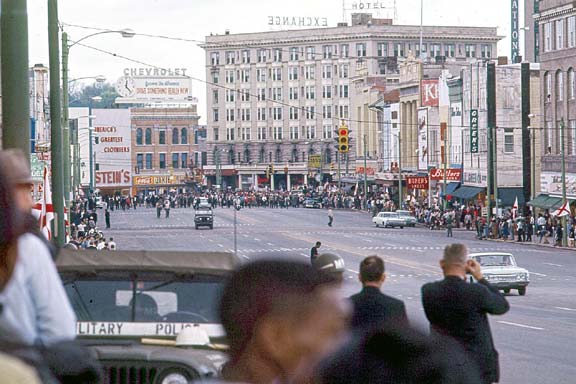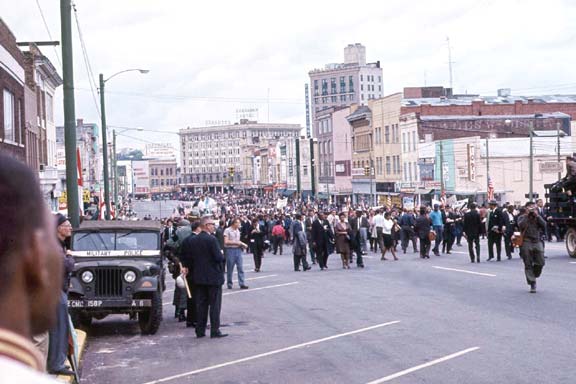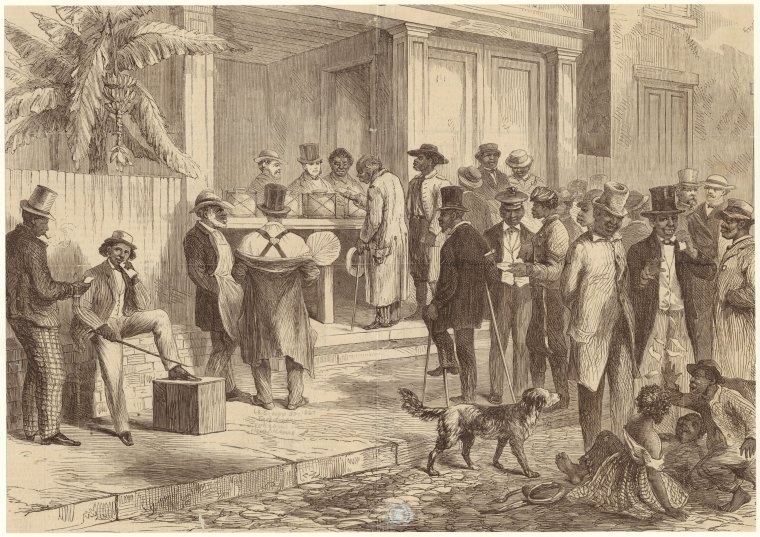Witnessing History
After the March: Voting Rights Act Promises New Era
Fred Stone was in college when he photographed the historic arrival of civil rights marchers in Montgomery, Alabama, in the spring of 1965. Now retired, he shared his photos with the California History Center at De Anza College. Historian David Howard-Pitney, a retired De Anza instructor, wrote the accompanying essay.

Marchers enter downtown Montgomery. (Fred Stone)

Marchers move up Dexter Avenue (Fred Stone)
On Aug. 6, President Lyndon Johnson signed into law the 1965 Voting Rights Act, which swept away many “colorblind” electoral procedures that were commonly used throughout the Jim Crow era to stifle Black voting.
The act also established federal monitoring of electoral rules and practices in states found to have histories of racial discrimination in voting. Under the law (and its extensions by Congress in 1970, 1975, 1982 and 2006), voting among African Americans burgeoned in the following decades, reaching national peaks in the 2008 and 2012 elections of President Barack Obama.
It is tempting to end the history of African Americans’ fight for the vote here, on a triumphant note. That narrative would go: "Once, American Blacks had been denied the vote, but then they got it during the civil rights movement and have exercised it freely ever since." But the battle for voting rights is not so one-directional – nor is it over. Rather, that history has seen periods of great progress, often followed by periods of reaction in which new forms of discrimination take root and flourish.
The great Selma Voting Rights Campaign, which intersected with a day in the life of young Fred Stone, connected both to the checkered past of voting rights history and to 21st-century events ahead.

President Barack Obama
(Pete Souza, The Obama-Biden Transition Project)
About a century before Selma and the Voting Rights Act, after the Civil War during Reconstruction, African American citizenship and voting rights had already been guaranteed in the 14th and 15th Amendments to the Constitution, and were temporarily enforced by the federal government and U.S. Army.
For a few years to a decade, depending on the state, multiracial democracy rose in the South during Reconstruction.
Blacks and whites in the Lincoln era’s Republican Party elected Southern state governments that, among other things, instituted the region’s first public schools.
But eventually in every ex-Confederate state, far-right terror combined with electoral politics by white so-called “redeemers” drove these biracially supported state governments from office.
At first, the all-white, racist, mostly Democratic Party state regimes were content just to have retaken power from the earlier biracial governments.

Freedmen vote in New Orleans, 1867 (Unknown artist)
But starting around 1890, white supremacist Southern states began holding state constitutional conventions for the openly stated purpose of eliminating all residual, post-Reconstruction voting by African Americans.
These states adopted many legal mechanisms for systematically disenfranchising Blacks, such as requiring literacy tests and poll taxes to qualify to vote. Then, after stuffing their constitutions with such voting restrictions, these conventions adopted the crowning “grandfather clause,” which exempted from these voting restrictions citizens whose grandfathers had been eligible to vote.
Although the convention delegates spoke bluntly about their aim to end voting by Blacks – using racist epithets openly in their remarks – the disenfranchisement measures adopted were carefully worded to be “colorblind,” or overtly nonracially discriminatory, so as not to be in obvious violation of the still-existent 15th Amendment.
In the Jim Crow era (circa 1900-1965) of legal racial segregation, lynch terror and Black disenfranchisement, these electoral rules and practices effectively denied Southern Blacks their right to vote. These were some of the same kinds of rules and practices against which the Selma demonstrators struggled in their battle to win the vote.
This story is told in five parts:
- Part 1: Marching for Justice
- Part 2: Bloody Sunday
- Part 3: Arriving in Montgomery
- Part 4: The Voting Rights Act
- Part 5: Freedom Is Never Free

